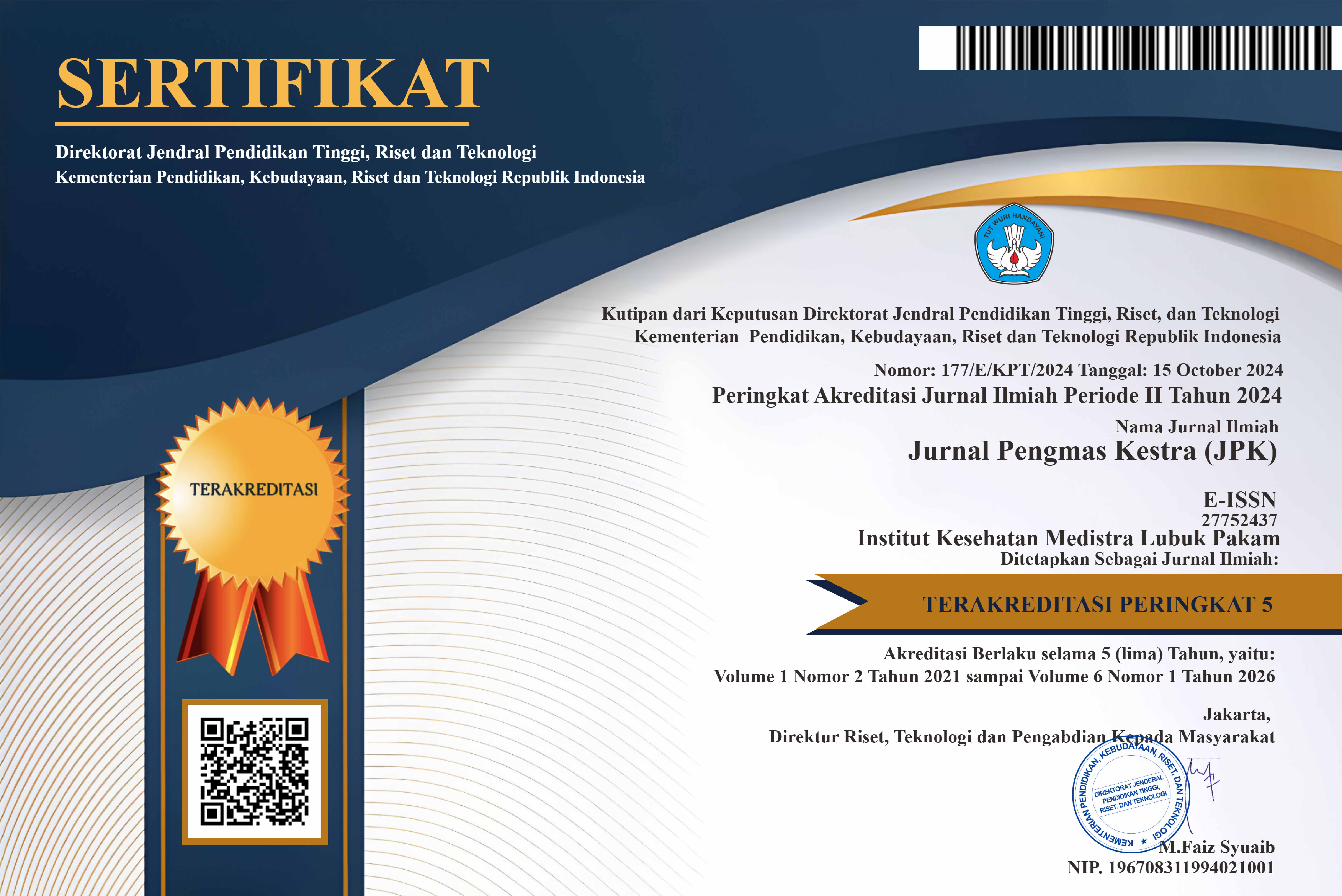Passion-Oranges Syrup Production Gung Pinto Village Tanah Karo
DOI:
https://doi.org/10.35451/jpk.v3i1.1697Keywords:
Product, Syrup, Oranges, Passion fruitAbstract
Syrup is a beverage product resulting from the production of a mixture of water and sugar at a content of not less than 65%, whether or not ingredients are in the form of food with or without food additives, which have received permission to use according to the regulations of the Food and Drug Supervisory Agency of the Republic of Indonesia. Fruit syrup is made from fresh fruit juice with sugar and the taste and aroma of the fruit. Fruits used in syrup production must have an attractive color, aroma and distinctive taste. Example the taste and aroma of passion fruit (Passiflora edulis S) and sweet orange (Citrus sinensis L). Sweet orange and passion fruit are used as a source of fruit syrup juice. Sweet oranges are widely grown in Indonesia, including North Sumatra, especially in Gung Pinto Village, Tanah Karo. During the main harvest, there is usually a decrease in the price of oranges so that farmers are reluctant to pick the fruit which has been the foundation of their lives. This problem triggers farmers to look for solutions so that their crops do not rot on the trees. Community Service is here to provide a solution by increasing the skills of the community to make Passion Fruit Syrup for the people in the village of Gung Pinto Tanah Karo. The service is carried out by training how to make Passion-Orange syrup by doing direct practice and evaluating the resulting product with a hedonic test. The results showed that the Passion-Orange syrup product showed very good color, taste, aroma and texture, and the public was very happy with the results of the Passion-Orange syrup product. The conclusion of the service shows that the syrup product produced is very good and the community is very happy with the results of the syrup product.
References
Achdiatsyah, M. R. (2013). Pembuatan Sirup Markisa dengan Kajian Penambahn Gula dan Konsentraasi Asam Sitrat sebagai Upaya Memperbaiki Mutu Sirup Markisa di Sulawesi-Selatan. In Skripsi. Universitas Brahwijaya.Malang.
Agustina, R., Fadhil, R., & Mustaqimah. (2021). Organoleptic Test Using the Hedonic and Descriptive Methods to Determine the Quality of Pliek U. IOP Conference Series: Earth and Achdiatsyah, M. R. (2013). Pembuatan Sirup Markisa dengan Kajian Penambahn Gula dan Konsentraasi Asam Sitrat sebagai Upaya Memperbaiki Mutu Sirup Markisa di Sulawesi-Selatan. In Skripsi. Universitas Brahwijaya.Malang.
Agustina, R., Fadhil, R., & Mustaqimah. (2021). Organoleptic Test Using the Hedonic and Descriptive Methods to Determine the Quality of Pliek U. IOP Conference Series: Earth and Environmental Science, 644(1).
Badan Standardisasi Nasional. (2013). SNI 3544:2013-Sirup. In Badan Standardisasi Nasional. Badan Standarisasi Nasional.
BPOM Republik Indonesia. (2019a). Peraturan Badan Pengawas Obat dan Makanan Nomor 11 Tahun 2019 tentang Bahan Tambahan Pangan. BPOM Republik Indonesia.
BPOM Republik Indonesia. (2019b). Peraturan Badan Pengawas Obat dan Makanan Nomor 34 Tahun 2019 tentang Kategori Pangan. BPOM Republik Indonesia.
BPOM Republik Indonesia. (2021). Peraturan Badan Pengawas Obat dan Makanan Nomor 29 Tahun 2021 tentang Persyaratan Bahan Tambahan Pangan Campuran. BPOM Republik Indonesia.
Chaaban, N., & Andersen, B. V. (2021). Sensory Specific Desires. The Role of Sensory Taste Exposure in Desire for Food with a Similar or Different Taste Profile. Foods, 10(12), 3005.
Dita, L. ., Sudarno, S., & Triastuti, J. (2020). Utilization of Agar Gracilaria sp. as a Natural Thickener on Liquid Bath Soap Formulation. IOP Conference Series: Earth and Environmental Science, 441(1), 1–4.
Firdaus, F., Kresnanto, V. A., & Fajriyanto. (2014). Variasi Kadar Sukrosa sebagai Bahan Pemanis dalam Formulasi Nutraseutikal Sediaan Gummy Candies Sari Buah Markisa Kuning (Passiflora Edulis Var. Flavicarpa). Teknoin, 20(4), 1–13.
Knudsen, N. R., Ale, M. T., & Meyer, A. S. (2015). Seaweed Hydrocolloid Production: An Update on Enzyme Assisted Extraction and Modification Technologies. Marine Drugs, 13(6), 3340–3359.
Mazmur, A., & Hasan, B. (2017). Penerapan Mesin Pengeruk Buah Markisa di Kecamatan Tombolopao Kabupaten Gowa. Prosiding Seminar Hasil Pengabdian Kepada Masyarakat, 2017, 70–75.
Rocha, I. F. de O., & Bolini, H. M. A. (2015). Passion Fruit Juice with Different Sweeteners: Sensory Profile by Descriptive Analysis and Acceptance. Food Science and Nutrition, 3(2), 129–139.
Samran, & Ali, R. (2019). Pembuatan Sediaan Sirup Jeruk Markisah di Desa Pematang Johar. Prosiding Seminar Nasional Hasil Pengabdian, 2(1), 562–566.
Samran, Suprianto, Gunawan, M., & Kusumastuti, M. Y. (2022). Evaluasi Konsentrasi Karboksi Metil Selulosa Alginat Formula Pasta Gigi. Jurnal Indah Sains Dan Klinis, 3(1), 20–24.
Suena, N. M. D. S., Ariani, N. L. W. M., & Antari, N. P. U. (2022). Physical Evaluation and Hedonic Test of Sandalwood Oil (Santalum album L.) Cream as an Anti-Inflammatory. Jurnal Ilmiah Medicamento, 8(1), 22–30.
Suprianto, Gunawan, M., Kusumastuti, M. Y., Fatimah, C., & Meilani, D. (2022). Evaluasi Stabilisator Agar-Agar dan CMC Sediaan Sirup Markisa Berastagi. Jurnal Indah Sain Dan Klinis, 3(1), 8–14.
Downloads
Published
Issue
Section
License
Copyright (c) 2023 Suprianto Suprianto, Sumardi Sumardi, Samran Samran, Debi Meilani, Dewi Kartika

This work is licensed under a Creative Commons Attribution 4.0 International License.
Copyright in each article is the property of the Author.




















